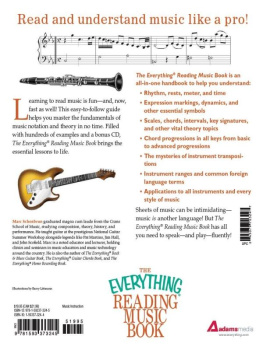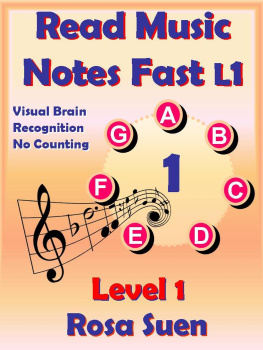Frank Desmond - HOW TO READ MUSIC FOR BEGINNERS: Learn The Basics Of Reading Music From Scratch To Advance Level
Here you can read online Frank Desmond - HOW TO READ MUSIC FOR BEGINNERS: Learn The Basics Of Reading Music From Scratch To Advance Level full text of the book (entire story) in english for free. Download pdf and epub, get meaning, cover and reviews about this ebook. year: 2020, genre: Children. Description of the work, (preface) as well as reviews are available. Best literature library LitArk.com created for fans of good reading and offers a wide selection of genres:
Romance novel
Science fiction
Adventure
Detective
Science
History
Home and family
Prose
Art
Politics
Computer
Non-fiction
Religion
Business
Children
Humor
Choose a favorite category and find really read worthwhile books. Enjoy immersion in the world of imagination, feel the emotions of the characters or learn something new for yourself, make an fascinating discovery.

- Book:HOW TO READ MUSIC FOR BEGINNERS: Learn The Basics Of Reading Music From Scratch To Advance Level
- Author:
- Genre:
- Year:2020
- Rating:4 / 5
- Favourites:Add to favourites
- Your mark:
- 80
- 1
- 2
- 3
- 4
- 5
HOW TO READ MUSIC FOR BEGINNERS: Learn The Basics Of Reading Music From Scratch To Advance Level: summary, description and annotation
We offer to read an annotation, description, summary or preface (depends on what the author of the book "HOW TO READ MUSIC FOR BEGINNERS: Learn The Basics Of Reading Music From Scratch To Advance Level" wrote himself). If you haven't found the necessary information about the book — write in the comments, we will try to find it.
Frank Desmond: author's other books
Who wrote HOW TO READ MUSIC FOR BEGINNERS: Learn The Basics Of Reading Music From Scratch To Advance Level? Find out the surname, the name of the author of the book and a list of all author's works by series.
HOW TO READ MUSIC FOR BEGINNERS: Learn The Basics Of Reading Music From Scratch To Advance Level — read online for free the complete book (whole text) full work
Below is the text of the book, divided by pages. System saving the place of the last page read, allows you to conveniently read the book "HOW TO READ MUSIC FOR BEGINNERS: Learn The Basics Of Reading Music From Scratch To Advance Level" online for free, without having to search again every time where you left off. Put a bookmark, and you can go to the page where you finished reading at any time.
Font size:
Interval:
Bookmark:
Learn The Basics Of Reading Music From Scratch To Advance Level
Copyright@2020
Frank Desmond
Western composed music is a language that has encountered different degree of development for a large number of years, and even the music we read nowadays has been around for more than 300 years. It is essential to take into cognizance that music notation is really the representation of sound with symbols, from fundamental notations for pitch, length, and timing, to more unpredictable or advanced descriptions of expression, tone, timbre and even special effects. This book will explain how notes are named and written; how to read melody, interpret time signatures, keys, sharps, flats, and naturals. This piece of writing will also introduce you to the nuts and bolts of reading music, show you various further developed techniques, and suggest a number of ways to get more knowledge about the subject.
1-Get a handle on the staff.

Prior to you are getting set to start learning music , you have to obtain a sense for the fundamental information that almost everyone who reads music should to know. The flat or horizontal lines on a bit of music make up the staff . This is the most fundamental of all musical symbols and the foundation for all that is to tag along or follow.
- The staff is an array of five equivalent or parallel lines, and the spaces among them. You have to know that both spaces and lines are numbered for purposes of reference, and are constantly counted from lowest (base of the staff) to highest (top of the staff).
2 -Start with the treble clef.

One of the first things you will come across when reading music is the clef . This sign, which seems like a large, fancy cursive symbol at the left end of the staff, is the legend that informs you just about what range your instrument will play in. Every voices and instruments in the higher ranges make use of the treble clef, and for this introduction to reading and understanding music, we will focus mostly on this clef for our examples.
- The G clef or treble clef, is gotten from an decorative Latin letter G. One excellent method to commit this to memory is that the line at the middle of the clef's "swirl" wraps in the region of the line that denotes the note G. Once notes are included to the staff within the treble clef, they shall have the following values:
- The 5 lines, from the base up, stand for these notes: E G B D F.
- The 4 spaces, from the base up, stand for these notes: F A C E.
- This may look like a lot to commit to memory, however you can make use of mnemonicsor word cuesthat might help you keep them in mind. For the lines, Every Good Boy Does Fine is one trendy mnemonic, and the spaces spell or bring out the word FACE. Practicing by means of an online note recognition tool is one more fantastic way to reinforce these associations.
3 -Understand the bass clef.

The bass clef, also called F clef, is utilized for instruments in the subordinate registers, plus the left hand of the piano, trombone, bass guitar, and so on.
- The name "F clef" takes from its genesis as the Gothic letter F. The 2 dots on the clef stretch out on top of and beneath the "F" line on the staff. The staff of the bass clef symbolizes different notes than that of the treble clef.
- The five lines, bottom to top, stand for these notes: G B D F A (Good Boys Don't Fool Around).
- The 4 spaces, base to top, stand for these notes: A C E G (All Cows Eat Grass).
4 -Learn the components of a note.

Individual note symbols are a mixture of up to 3 essential components: the note head, the flags and stem.
- The note head . This is an elliptical shape that is either open (white) or shut (dark). At its most basic, it informs the artist what note to play on their instruments.
- The stem . This is the slim vertical line that is appended to the note head. Once the stem is pointing up, it connects on the right part of the note head. Once the stem is pointing down, it connects the note head on the left. The direction of the stem does not have consequence on the note, however it makes notation simpler to interpret or read and a lesser amount of cluttered.
- The common rule on stem direction is that at or beyond the middle line (B for treble clef or D for bass clef) of the staff, the stem points downward, and once the note is beneath the center of the staff, the stem points up.
- The flag . This is the curled stroke that is joined to the end of the stem. Regardless of whether the stem is attached to the right or left of the note head, the flag is at all times drawn to the right of the stem, and by no means to the left!
- Taken together, the note, stem, and flag or flags demonstrate to the performer the time worth for any specified note, as measured in beats or portions of beats. Every time you listen to music, and you are tapping or drumming your foot in time to the music, you are recognizing that beat.
1 -Learn about measure lines.

On a piece of sheet music, you would notice thin vertical lines crossing the staff at moderately regular intervals. These lines symbolize measures (known as bars in a number of places); the space prior to the first line is the first measure, the space among the first and second lines happens to be the second measure, and so on. There is need to take into cognizance that measure lines don't have an effect on how the music sounds, however they help the artist maintain their place in the music.
- As we will see beneath, another handy thing about measures is that each one obtains the same amount of beats. For instance, if you see yourself tapping "1-2-3-4" along to a bit of music on the radio, you have possibly intuitively found the measure lines already.
2 -Learn about timing, or meter.

Meter can be usually thought of as the pulse or the beat of music. You sense it unconsciously or intuitively once you listen to dance or pop music; the boom, tiss, boom, tiss of a stereotypical or conventional dance track is a straightforward example of meter.
- Upon a bit of sheet music, the beat is articulated by something that seems like a fraction written next to the first clef symbol. Similar to any part, there is a denominator, and a numerator. The numerator, written in the zenith two spaces of the staff, informs you how numerous beats there are in one measure. The denominator informs you the note worth that receives one beat (the pulse that you tap your toe to).
- Maybe the simplest meter to comprehend is 4/4 time, or common time. In 4/4 time, there are 4 beats in every measure and every quarter note is equivalent to one beat. This is the time signature you will hear in most trendy music. You can count along to general time music by counting ONE two three four ONE two three four... to the beat.
Font size:
Interval:
Bookmark:
Similar books «HOW TO READ MUSIC FOR BEGINNERS: Learn The Basics Of Reading Music From Scratch To Advance Level»
Look at similar books to HOW TO READ MUSIC FOR BEGINNERS: Learn The Basics Of Reading Music From Scratch To Advance Level. We have selected literature similar in name and meaning in the hope of providing readers with more options to find new, interesting, not yet read works.
Discussion, reviews of the book HOW TO READ MUSIC FOR BEGINNERS: Learn The Basics Of Reading Music From Scratch To Advance Level and just readers' own opinions. Leave your comments, write what you think about the work, its meaning or the main characters. Specify what exactly you liked and what you didn't like, and why you think so.











